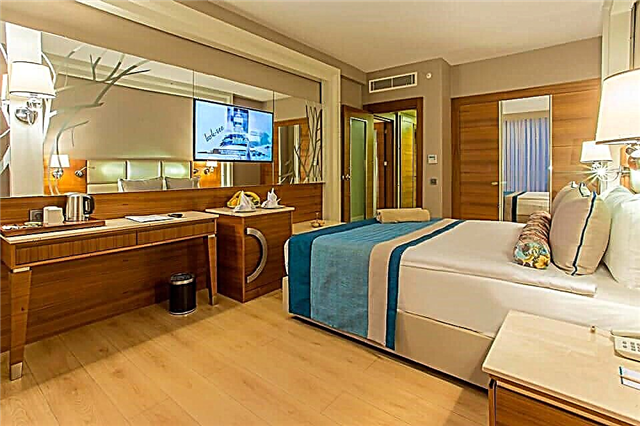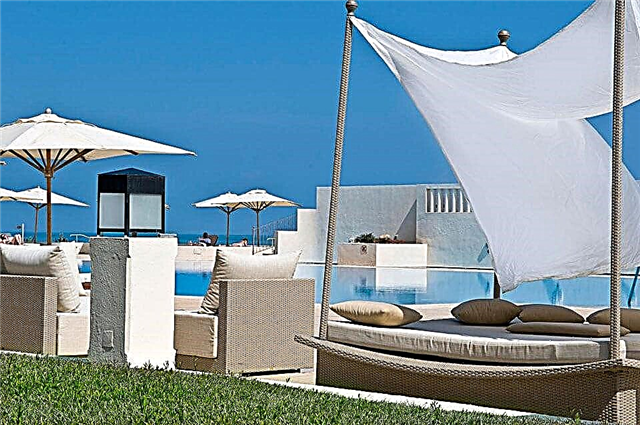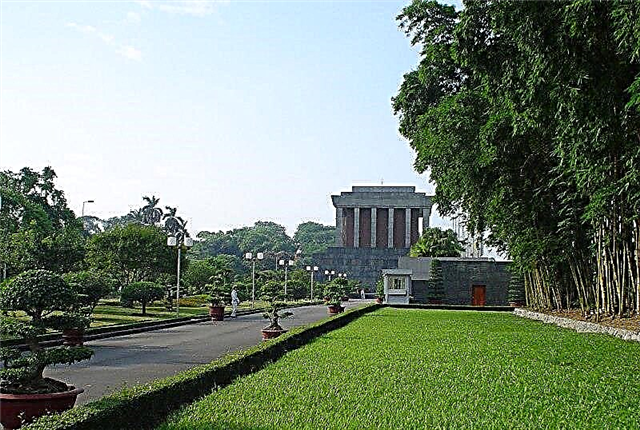Small old Suzdal, which is home to less than 10 thousand people, can be safely called a Russian city-museum. In addition to the ancient monasteries and temples that have survived to this day, the city can show guests more than a dozen interesting museum collections. Several rich collections belong to the Vladimir-Suzdal Museum-Reserve. Some of the museums are located in the open air, and some expositions are housed in state-protected architectural monuments of the 17th-19th centuries.
Spaso-Evfimiev monastery museums
Article: Spaso-Evfimiev monastery - monastery-fortress

Cathedral of the Transfiguration of the Savior and the bell tower in the Savior-Euthymius Monastery
The oldest Orthodox monastery in the city presents several museum collections to travelers who come to the city. The main one tells about the history of the creation of Christian monasteries on the Suzdal land. The monastery houses icons of the 18th-20th centuries, vestments of clergymen and ancient vessels that were used for church services. In the monastery you can also see amazingly beautiful frescoes created in the 17th century by the famous Russian iconographer Guriy Nikitin.
In the halls of the Archimandrite Corps there is a permanent exhibition of old books and manuscripts. And the Nikolsky Church houses a collection of more than 500 objects of decorative and applied art - colored enamels, exquisite chasing, skillful embroidery and jewelry. In the monastery there is also a museum of the history of the Suzdal prison, and between the buildings there is a real “Pharmaceutical garden”.
How does it work: Except Monday from 10.00 to 18.00.
Where is located: st. Lenin
Suzdal Kremlin museums
Article: Suzdal Kremlin - the heart of the ancient city

View of the Suzdal Kremlin
The construction of the city began in the 12th century from the place where the Kremlin is located today. Therefore, the main museum collections tell about the history of the Suzdal lands. Here are presented interesting archaeological finds made by specialists during excavations in the city. In the halls of the museum you can see the armor of Russian warriors and the Golden Horde, ancient dishes, icons and crosses, as well as products of Suzdal blacksmiths and manufactures.
The spacious Krestovaya chamber displays pieces of furniture of the 18th century, an old stove and oak benches for guests, which were covered with red cloth. A unique museum center for children has been created in the former Bishops' Chambers. The young guests of the museum are presented with curious toys, which were played by children of peasants, merchants and nobles. In addition, children can see old school writing materials and teaching aids, according to which schoolchildren mastered the basics of science in the 19th century. The recently renovated Nativity Cathedral houses the unique Golden Gate, which depicts various biblical stories. Well, and of course, having arrived at the Suzdal Kremlin, one cannot pass by the permanent exhibition of works of Old Russian painting.
How does it work: From 10.00 to 18.00, except Tuesday.
Where is located: st. Kremlin, 3
Museum of Wooden Architecture
Article: Suzdal Museum of Wooden Architecture and Peasant Life - makeshift village in Suzdal

Entrance to the Museum of Wooden Architecture
It was decided to create an unusual museum in the 1960s. And the place for it was chosen where the Dmitrov monastery, which had not been preserved, once stood. Ancient wooden buildings were brought here from old villages. And gradually, thanks to the efforts of historians and restorers, a museum was created, telling not only about the traditions of Russian wooden architecture, but also about how peasant life looked like in Russian villages.
The oldest building on the territory of the museum was built in the middle of the 18th century. This is a warm St. George Church. Almost simultaneously with it, a wooden Transfiguration Church was built, brought here from the village of Kozlyatyevo. In a wooden house that previously belonged to the Agapov merchants, there is an exposition telling about the traditions of the Suzdal merchants. On the territory you can also see which huts were built for themselves by well-to-do peasants, and which peasants could afford to be poorer, the so-called "middle peasants". There are wooden wells, an old mill, barns, sheds, barns and other buildings typical of a peasant farmstead. In summer, many colorful festivals take place on the museum territory.
How does it work: From September 1 to April 25: from 9.00 to 16.00, except Wednesday. From April 26 to August 31: from 9.00 to 19.00 seven days a week.
Where is located: st. Pushkarskaya - on the banks of the Kamenka river
Prikaznaya hut

Prikaznaya hut of the Intercession Monastery
The one-story stone building of this museum was built at the beginning of the 18th century. It is a rare example of a non-cult building that has survived since that time. The museum is located on the territory Intercession monastery... All documents sent to old Suzdal from the capital passed through the clerk hut - the emperor's decrees and letters of gratitude. And from here, petitions were sent to Moscow with various requests. In addition, peasants and monks who were convicted of offenses were brought to the clerk's hut and, while the proceedings were going on, they were kept in a stone basement. In the museum, you can see carefully recreated rooms and furniture from three hundred years ago, as well as an exhibition telling about the history of the Intercession for Women.
How does it work: Except Wednesday and Thursday from 10.00 to 18.00.
Where is located: st. Pokrovskaya, 76
Posad house
Article: Museum "Posad House" - a rare monument of residential stone architecture

View of the Posad House from the Smolensk Church
An unusual monument of Russian architecture of the 17th-18th centuries is located not far from the Spaso-Evfimiev monastery. This is an old stone residential building. And for more than 300 years of its existence, it has grown deep enough into the earth. It is curious that the architecture of the stone building repeats the traditional forms of wooden buildings.
The windows of the house are decorated with carved frames. The western part of the building has one floor, and the eastern part has two. Downstairs there was a utility room - a basement, and on the second floor there was a master's room, and a narrow spiral staircase led there. Inside the posad house, the interiors of the living rooms of the late 17th - early 18th centuries have been recreated. It is believed that the owners of such a building could be priests, taverns or kalachniks.
How does it work: Daily 10.00 to 17.00 (on Wednesdays and Fridays - until 16.00). Day off - Thursday.
Where is located: st. Lenin, 148
"Shchurovo settlement"

Entrance to the "Shchurovo settlement"
1 km north-west of the old Spaso-Evfimoyev Monastery, on the bank of the Kamenka River, there is an interactive museum complex "Shchurovo Settlement". In this open-air museum you can visit old huts, recreated in the traditions of pre-Petrine wooden architecture, as well as see animals and birds that were traditionally raised on peasant farmsteads. On the spacious grounds, visitors can ride horses, try their hand at archery and learn to wield the sword of a Russian warrior. This unusual museum also makes feature films, documentaries and historical reenactments of old battles.
How does it work: On Saturday from 11.00 to 16.00, on Sundays - until 14.00.
Where is located: st. Cowsheds, 14
The Wax Museum

Wax Museum building
The exposition of this Suzdal museum is dedicated to the characters of Russian history of the 9th-19th centuries. It occupies several halls and a basement with an area of 200 sq. m and is located in an old mansion with a mezzanine, built in the 19th century near the Kremlin. The collection features over 150 wax figures. These are human-sized figures depicting Russian emperors, leaders of the Soviet state, political and public figures, famous military leaders, musicians and poets. Real masters worked on their creation, who managed to achieve an amazing portrait resemblance. In the lobby of the museum, souvenirs with the symbols of Suzdal are sold.
How does it work: 7 days a week from 10.00 to 19.00.
Where is located: st. Kremlin, 10V
Icon painting workshop "Sofia"

The museum is located in the Nativity of Christ Church
In the Nativity of Christ Church, located on one of the central Suzdal streets, an unusual museum has been created, introducing visitors to the technique of creating icons and wall paintings. It is also led by an unusual and very talented person - the priest of the church, Father Andrey (Davydov). For guests, they conduct a tour of two old Suzdal temples and talk about the role of icon-painting images and milestones in the history of Russian icon painting.
In addition, visitors to the museum under the guidance of the master can try to paint a small fragment of the fresco themselves. Father Andrey shows guests one of the most ancient icon-painting techniques - "encaustics", which isographers used to create icons until the 12th century. Using this technique of writing, images are created using natural dyes mixed with hot wax. The wax shell makes the color of the icon more vivid and protects it from aging and fading.
How does it work: By appointment and agreement with Father Andrey.
Where is located: st. Lebedev - at the St. Nicholas Church











